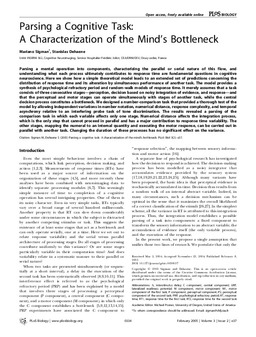| dc.rights.license | https://creativecommons.org/licenses/by/4.0/ | es_AR |
| dc.contributor.author | Sigman, Mariano | es_AR |
| dc.contributor.author | Dehaene, Stanislas | es_AR |
| dc.date.accessioned | 2018-08-18T17:36:13Z | |
| dc.date.available | 2018-08-18T17:36:13Z | |
| dc.date.issued | 2005-02-08 | |
| dc.identifier | doi: 10.1371/journal.pbio.0030037 | es_AR |
| dc.identifier.uri | https://doi.org/10.1371/journal.pbio.0030037 | es_AR |
| dc.identifier.uri | https://repositorio.utdt.edu/handle/20.500.13098/11089 | |
| dc.description.abstract | Parsing a mental operation into components, characterizing the parallel or serial nature of this flow, and understanding what each process ultimately contributes to response time are fundamental questions in cognitive neuroscience. Here we show how a simple theoretical model leads to an extended set of predictions concerning the distribution of response time and its alteration by simultaneous performance of another task. The model provides a synthesis of psychological refractory period and random-walk models of response time. It merely assumes that a task consists of three consecutive stages—perception, decision based on noisy integration of evidence, and response—and that the perceptual and motor stages can operate simultaneously with stages of another task, while the central decision process constitutes a bottleneck. We designed a number-comparison task that provided a thorough test of the model by allowing independent variations in number notation, numerical distance, response complexity, and temporal asynchrony relative to an interfering probe task of tone discrimination. The results revealed a parsing of the comparison task in which each variable affects only one stage. Numerical distance affects the integration process, which is the only step that cannot proceed in parallel and has a major contribution to response time variability. The other stages, mapping the numeral to an internal quantity and executing the motor response, can be carried out in parallel with another task. Changing the duration of these processes has no significant effect on the variance. | es_AR |
| dc.format.extent | 16 p. | es_AR |
| dc.format.medium | application/pdf | es_AR |
| dc.language | eng | es_AR |
| dc.relation.ispartof | PLoS Biology 3(2):, (2005). ISSN: 1545-7885 | es_AR |
| dc.rights | info:eu-repo/semantics/openAccess | es_AR |
| dc.title | Parsing a cognitive task : a characterization of the mind’s bottleneck | es_AR |
| dc.type | info:eu-repo/semantics/article | es_AR |
| dc.subject.keyword | Cognition | es_AR |
| dc.subject.keyword | Sensory perception | es_AR |
| dc.subject.keyword | Convolution | es_AR |
| dc.subject.keyword | Decision making | es_AR |
| dc.subject.keyword | Probability distribution | es_AR |
| dc.subject.keyword | Event-related potentials | es_AR |
| dc.subject.keyword | Random walk | es_AR |
| dc.subject.keyword | Sensory physiology | es_AR |
| dc.type.version | info:eu-repo/semantics/publishedVersion | es_AR |
| dc.description.filiation | Fil: Sigman, Mariano. Unité INSERM 562, Cognitive Neuroimaging, Service Hospitalier Frédéric Joliot, CEA/DRM/DSV, Orsay, France. | es_AR |
| dc.description.filiation | Fil: Dehaene, Stanislas. Unité INSERM 562, Cognitive Neuroimaging, Service Hospitalier Frédéric Joliot, CEA/DRM/DSV, Orsay, France. Collège de France, Paris, France | es_AR |

